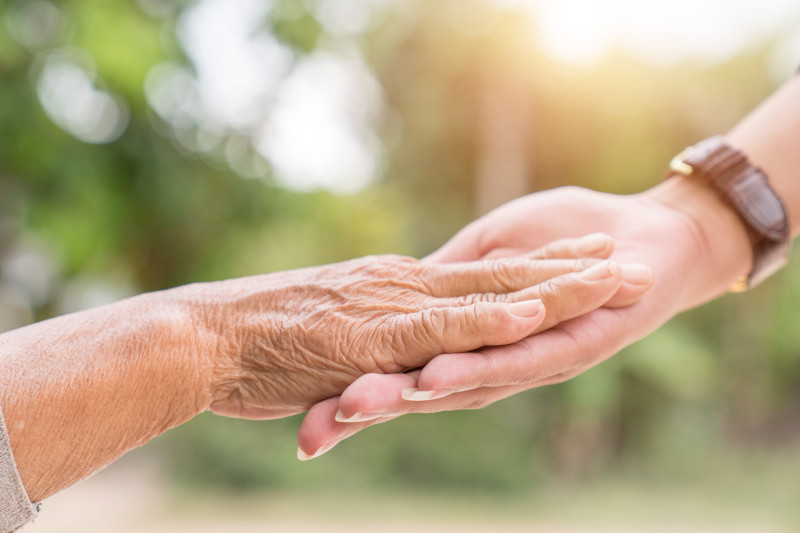AARP Hearing Center

When Carol B. Amos began Alzheimer's caregiving for her mother, she learned that help, organization, preparation, and education, or H.O.P.E., helped her navigate the various stages of the journey.
Amos, author of the book “H.O.P.E. for the Alzheimer’s Journey: Help, Organization, Preparation, and Education for the Road Ahead,” shared her experience in a recent program presented by Insight Memory Care, in collaboration with AARP Virginia.
Amos’ mother, an active, vibrant member of her community and church, demonstrated early Alzheimer’s symptoms around the time of her 83rd birthday. At the time, her mother lived independently in Cleveland. Amos and her two brothers all lived out of state, yet they worked together as a care team along with medical professionals, friends, and community members to help honor her wish for independence.
When their mother began exhibiting uncharacteristic behaviors, like claiming she had been picked up by strangers and was missing a $5,000 check, the siblings decided to move her to assisted living. They staged an intervention to help her realize that the move was for safety, health, home management, and socialization reasons.
They chose a facility in Cleveland because of their mother’s network of friends and contacts. The move was stressful, but eventually she established a routine and became more comfortable.
Throughout this first stage, which Amos labeled “Discovery,” Amos utilized help in the form of assistance from family, social workers, neighbors, and friends. She organized medical and financial paperwork, the emptying and sale of her mother’s house, and the move to assisted living.
Preparation included research and visiting of the new facility, and Amos educated herself with visits to the Alzheimer's Association office and working with medical personnel.
After about three years in assisted living, her mother started exhibiting increased signs of memory loss. She engaged in repetitive behavior, such as constantly checking doors at the facility to assure they were locked. Staff feared she would lock herself out. The siblings decided it was time to move her to a memory care facility.
They decided a memory care facility in Delaware, where Amos lived, would be the best solution. The facility was smaller and had more structure, and their mother, after some initial disorientation, soon fell into a routine.
Amos learned to live in the patient’s world to help her mother minimize anxiety. She engaged her mother in stimulating activities, such as getting her involved in finding her doctor’s office. Her mother had good and bad days, and her decline progressed slowly.
Amos’ help during this second phase of the journey, which she called “Thrive,” came in the form of new doctors and others, such as Amos’ church friends, to form a new circle of support. She organized her mother’s papers, keeping copious spreadsheets of her medications and expenses, which helped her project when her mother might run out of funds.
Preparation came in the form of stimulating social outings. She also spent time researching nursing homes, hospice care, and funeral homes. Support groups and more Alzheimer’s Association workshops helped Amos continue her education.
Amos’ mother showed considerable decline during the last two years of her life, during the phase Amos called “Winding Down.” She became less verbal but was still aware of her surroundings. Amos said her mother considered the memory care facility a “safe haven” that she treated as her home.
Although she was hospitalized several times during this period, which was unsettling, her mother never lost her spirit, even as her health declined.
About one week prior to her death, Amos’ mother stopped eating. The care team placed her in hospice care, and she passed away peacefully at age 94.
During this last phase, Amos sought additional help from the memory care staff, and organized the removal of the contents of her mother’s room. She planned the funeral logistics and continued her education journey with Alzheimer’s workshops.
Amos shared several key points she learned throughout her Alzheimer’s care journey. Acceptance is critical, she said. Carers must understand that the care person has changed, and caring is difficult and unpredictable. With her mother, she said, she still tried to “push her to do her best” and treat her with respect.
Decision making is also a constant process, said Amos, and should involve the broader circle of support. “There are no right or wrong decisions,” said Amos, and each decision is personal to the situation.
Amos strongly recommends carers “make taking care of yourself a priority,” and be aware that one can’t do it all by oneself. She urges carers to be current on their own medical needs and utilize stress relief routines, such as regular exercise. “Do something you enjoy monthly,” said Amos.
For more information about caregiving resources, visit AARP.org/caregiving.































































